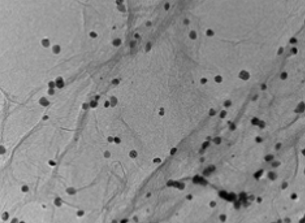Gold Nanoparticle Characterization Using the iEM Platform
Gold nanoparticles (AuNPs) are one of the most commonly utilized nanomaterials due to their unique properties, such as their stability and optical properties. In order to promote AuNPs applications in medicine and pharmacology, accurate sample characterization is needed but technically demanding. Here, we offer high-quality imaging techniques to analyze AuNPs, including transmission electron microscopy (TEM) and scanning electron microscopy (SEM).
Gold Nanoparticles (AuNPs)

Gold nanoparticles (AuNPs) have attracted extensive attention from the scientific community since the beginning of the 20th century due to their unique physicochemical and biological properties. Nowadays, these nanoparticles are of interest in a number of fields, including cosmetology, biology, clinical chemistry, medicine, and pharmacology. The advanced properties of AuNPs, such as biocompatibility, extensive surface-to-volume ratio, significant surface modifiability, make them excellent non-toxic carriers for drug delivery and for targeting specific cells or tissues. So far, a variety of biocompatible polymers have been utilized for surface modification of AuNPs to improve their stability, payloads capacity, cellular absorption capacity, and blood circulation time. For example, biopolymer-conjugated AuNPs are applied in delivery systems, diagnostics, biosensing, and other applications. AuNPs coated with PEG brush can avoid uptake by phagocytes and degrade in cells. As multifunctional agents, AuNPs can be used for combined therapy and diagnostics (theranostics). AuNPs have become highly feasible materials used in cancer treatment.
Characterization of Gold Nanoparticles at the iEM Platform

Creative Biostructure has been providing validation, feasibility, and qualification studies for the analysis of inorganic nanoparticles for different companies in drug delivery and other biological applications. We focus on the design and acceptance criteria for each particle characterization scheme and are dedicated to providing suitable and specific analytical procedures using advanced EM technologies. Creative Biostructure’ solutions for analyzing gold nanoparticles, including,
- Basic characterization of AuNPs
- Intracellular localization of AuNPs
SEM and TEM are combined to examine the morphology, size, particle shape distribution of AuNPs, and the presence of aggregation. In addition, the elemental composition of the AuNPs can be obtained by TEM in conjunction with energy dispersive spectrometry (EDS).
TEM currently provides detailed information on the uptake and localization of nanoparticles by visualizing their location in target cells and/or tissues. TEM can provide nanoscale resolution to precisely locate diffused AuNPs in cells and give detailed comparative results involving cell morphology changes.
Application of Our Services
- Quality control of AuNP products.
- Promote the development and production of AuNPs prepared with different methods.
- Study and analyze the penetration of AuNPs in different tissues.
Creative Biostructure provides the iEM Platform to help customers analyze and characterize nanoparticles, viral-based biotherapeutics, and other applications in biotherapeutic development and production. Whether you need sophisticated analytical services to identify nanoparticles or a broader interpretation of analytical data, our experienced experts team are committed to meeting your needs. If you have any further questions about our solutions or platform, make sure to contact us, and our experienced electron microscopy experts will help you.
- Dzimitrowicz, A., et al. (2019). "Preparation and characterization of gold nanoparticles prepared with aqueous extracts of Lamiaceae plants and the effect of follow-up treatment with atmospheric pressure glow microdischarge." Arabian Journal of Chemistry, 12(8), 4118-4130.

